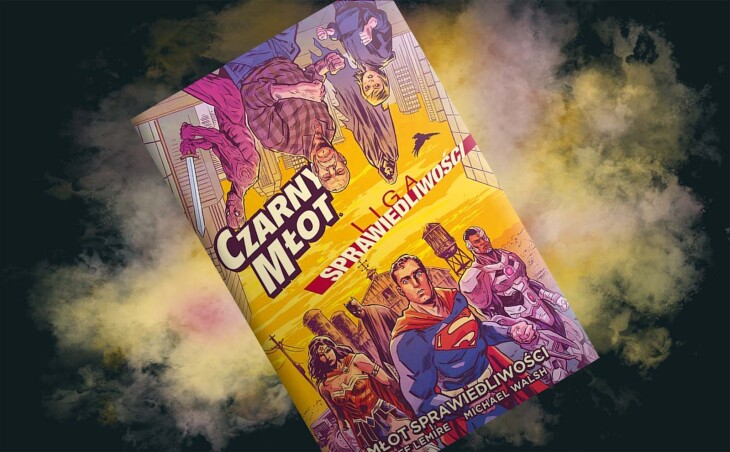DC’s crossovers were launched in 1961, when Barry Allen, The Flash of the Silver Age, met Jay Garrick – his Golden Age counterpart. Since then, the superheroes have mixed up frequently and densely in various combinations. However, it wasn’t until a dozen years later, in 1976, that Superman vs. The Amazing Spider-Man , which set a precedent for creating stories with heroes from various publishing houses. DC heroes have already performed with heroes from Star Trek (2016), Ninja Turtles , Power Rangers, and even … cartoon characters from Hanna-Barbera.
Hammer of Justice is a strange case because Black Hammer has already ended, at least in terms of the main storyline (because spin-offs are made in bulk). And the latest Jeff Lemire comic takes place before the Era of Doom , the final plot (which was very so-so, but less so), being a rare phenomenon known as a midquel . This is slightly confusing, especially since the reader thus knows that he will not get anything relevant to the entire plot, since the ending is already known to him. Probably aware of this, the Canadian creator focused on entertainment full of blinking eyes at fans.
Unexpected swap of seats
Well, we meet again the heroes of the Blackhammer trapped on a mysterious farm. Although it only takes a short while, because thanks to a mysterious gentleman, places are swapped with the heroes from DC. Abraham Slam and the rest end up in Metropolis during the Starro invasion. On the one hand, they are free from their captivity for the first time in years, but they are also met with hostility from other members of the Justice League. Meanwhile, Batman, Superman, Wonder Woman, Cyborg and Flash are transferred to Rockwood, where they try to get out of captivity for ten years.
To this day, I consider the first volumes of The Black Hammer to be a good superhero story. The world has already seen many alternative versions of DC superheroes, and the very original versions of Superman have already been created countless. Yet Lemire was able to create something of value on this ground. While the characters from the Blackhammer are very clear tributes to the Silver and Golden Era, what worked was weaving them into unusual realities. Showing powerful characters that must lead a normal life, where their powers and uniqueness do not exist is a great starting point, which in the Hammer of Justiceis… abandoned. Lemire took a shortcut here and created a solid but very clichéd crossover. Groups are switched places, this leads to initial conflicts, but eventually an agreement is reached and the status quo is restored .
Crossover as in the textbook
And chirp, the comic drummed. It is quite decent reading and I had a lot of fun reading it. The problem is that from Lemire and his world of authorship, I expect more than just a textbook example of a crossover. And while watching the League members recreate scenes known from the previous adventures of Blackhammeror trying to find themselves in the new reality (Bruce Wayne patrolling the streets of a small town) is nice, so the events in Metropolis are already very clichéd. In this situation, Slam and the rest are just another superhero that has been created by a dime a dozen. This is perfectly illustrated by an example from the comic itself: the red-skinned Barbalien comes from Mars, hence when confronting the Martian Hunter of People, he claims that the latter is an impostor, because the inhabitants of the red planet are not green. It laughs the first time, but the exchange comes back a couple of times, making it crude. The exhibition, which tries (especially at the beginning) to present both groups of characters to readers unfamiliar with them, is also problematic in places. Worse, if you already know these characters, then the dialogues fall out artificially and heavy.
I am also surprised to make a secret about who caused all the fuss. I suspected from the outset who the sinister figure in the hat was, and revealing her identity later was anything but a good twist. Why make a puzzle out of it when the answer is “obvious”?
Fine
This time Lemire limited himself only to the role of a screenwriter. Michael Walsh is responsible for the graphic layer, who fulfilled his task decently. You can even say that what comics, such drawings. His style is not distinguished by anything special, which brings him closer to the flagship DC titles than the author’s comics, or even the style of Dean Ormston, known from the basic series. Fortunately, it’s a lot better here than with another spin-off, Blackhammer ’45 , but it’s hard to find a more hideous comic book. The release is exactly the same as in the case of its predecessors – paperback, and in the add-ons you can find a gallery of alternative covers, of which over twenty appear!
There is nothing new under the hammer
At one time I was very impressed with the comic book Justice Leauge vs Power Rangers, which is my favorite crossover at the moment. Everything there was done perfectly, the pages were bursting with creativity, and the dialogues were brilliant. Against this background, the Hammer of Justice looks rather bleak. Instead of playing with superhero themes, check them off. The reading was pleasant anyway, even Lemire’s clichéd title is an efficient craftsmanship anyway. At the same time, the reader has the right to expect more from this writer.
Nasza ocena: 6.2/10
In the past, the Black Hammer series meant creative play with superhero clues. However, with items such as the Hammer of Justice it is hard to distinguish it from mainstream titles.Characters: 7/10
GRAPHIC DESIGN: 6/10
STORY: 5/10
EDITION: 7/10

